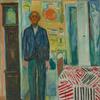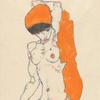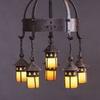Oklahoma City Museum of Art receives 50 Photographs from Brett Weston Archive and Christian K. Keesee Collection
- OKLAHOMA CITY, Oklahoma
- /
- January 05, 2016
The Oklahoma City Museum of Art has received 50 gelatin silver prints by American photographer Brett Weston (1911-1993) from the Brett Weston Archive and Christian Keesee Collection. The photographs in the donation were taken between 1937 and 1980 and consist predominantly of the natural and material abstractions for which the artist became known. Photographs such as lily pad, water, Europe (1968), terraced fields, Mexico (1964), and sculpture, Europe (ca. 1970) reference Brett's extensive travels. He also spent a considerable amount of time in California and Hawaii, photographing images such as lava, Hawaii (ca. 1980) and desert landscape, California (ca. 1950).
"Thanks to Mr. Keesee's vision and generosity, the Oklahoma City Museum of Art has one of the largest collections of Brett Weston photography in the world," said E. Michael Whittington, President and CEO. "Brett Weston, together with his father Edward, was one of the pioneering artists who fundamentally transformed early twentieth century photography into the art form we appreciate today. We are deeply honored that Christian Keesee and the Brett Weston Archive have designated the Museum as the steward of this important legacy."
Brett Weston, the second son of photographer Edward Weston, was born in Los Angeles in 1911. In 1925, at the age of thirteen, Brett began taking photographs on a trip to Mexico with his father's Graflex 3 ¼ x 4 ¼ camera. While there, he was exposed to the works of Diego Rivera, José Clemente Orozco, and Tina Modotti, who influenced his sense of form and composition. Brett returned to California with his father in 1926 and began to exhibit his own works, while assisting Edward in his portrait studio. Brett's work received international attention after being included in the important 1929 Film und Foto exhibition held in Stuttgart, Germany.
During the Second World War, Brett worked briefly as an assistant cameraman for Twentieth Century Fox, before being drafted into the Army. Stationed with the Signal Corps in New York City in 1944, Brett took photographs of the city with his 8 x 10 and 11 x 14 cameras when off-duty and made important contacts in the photographic world. The following year, he was assigned to the Army base in El Paso, Texas, where he became a sergeant, and began photographing the nearby gypsum dunes of White Sands National Monument. Brett was discharged from the Army in 1946 and spent the following year taking photographs of the East coast on a Post Service Guggenheim Fellowship.
Brett's work often incorporates the use of close-ups and abstracted details, displaying a preference for high-contrast imagery, which reduces his subjects to pure form. Throughout his career, he has repeatedly photographed subjects including tangled kelp, plant leaves, and knotted roots and has made numerous photography trips to Europe, Baja California, Oregon, Alaska, and Hawaii, among other locations. Brett's work became increasingly abstract in the 1970s as he began to more fully utilize a 2 ¼ inch format reflex camera. He spent a considerable amount of time taking photographs in Hawaii, during the 1980s, before his death in his Kona home in 1993.
Since 2004, Christian Keesee has donated 460 photographs from the Brett Weston Archive. The recent gift makes the Oklahoma City Museum of Art the second largest public collection of Brett Weston's photography in the United States.
The Brett Weston Archive was established in 1997 by Christian Keesee, widely recognized as a prominent art collector, who purchased the entire inventory from the critically acclaimed American photographer's estate.







100x100_c.jpg)







